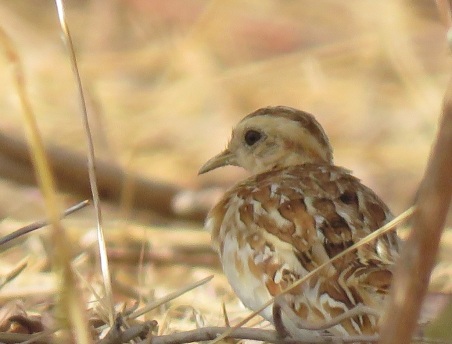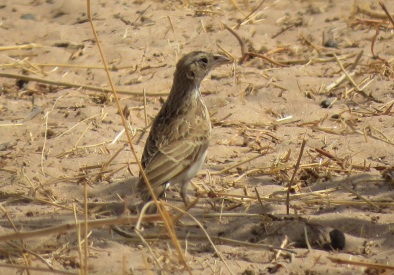Quest for a Ghost

A day off and not much going on at Technopole recently (water levels are too low, most migrants have moved on) means that I finally have some time to write up this long overdue post. At long last I managed to “catch up” as they say on a very special bird, part quail, part plover – or is it half lark, a quarter courser and a quarter chameleon? Either way, our third attempt to find the unique Quail-Plover (Turnix à ailes blanches) finally paid off with some superb sightings of two different birds, nearly three weeks ago somewhere south of Touba/Mbacke in central Senegal’s barren bush country. I’m pretty sure that this diminutive bird, which of course is neither a plover, nor a quail or lark (let alone a chameleon), easily ranks in the top 10 of most wanted birds to be found in Senegal. Secretive yet not shy, it’s notoriously hard to find in the vast expanse of suitable habitat throughout central Senegal. and earlier attempts back in February and June 2018 failed to turn up any Quail-Plovers.
So, we set off ridiculously early (well maybe not for most birders, but for me 5.30am is VERY early) one Saturday morning and took the shiny new highway to Touba (merci la cooperation chinoise, Senegal now has an additional 1 billion or so Euros in debts to reimburse). Within no time we reached Touba and zoomed through the usually very busy town of Mbacke, all being quiet as it’s Ramadan season here. A few kilometres past the surprisingly clean town of Tip, for Senegalese standards that is, we took what looked like a more or less driveable track heading in the direction of a known spot for Quail-Plover. I somehow managed to get a pretty impressive puncture thanks to a sharp piece of bone (I’m guessing a goat’s femur, see below: opinions welcome), but by 8.30 we were out in the field, birding with a purpose.
Endlessly kicking bushes and slaloming one’s way through the bush country seems to be the only way to nail down this ghost bird. Preferably in a large group, definitely not on your own or with just one mate…

Quail-Plover country
Not really sure whether we really stood any chance, and hopes slowly diminishing as we kicked along without much of a result for about an hour, Miguel finally started frantically gesturing some distance away. Sure enough, he’d found one!
A short sprint later I finally saw what must be one of the most unique birds I’ve ever seen:

YES!!

Quail-Plover / Turnix à ailes blanches
We ended up watching this bird for at least half an hour as it slowly moved from one bush to another, typically rocking back-and-forth just like a chameleon, at times feeding but always keeping a watchful eye on us. We finally moved on, both of us all ecstatic of course, like two boys who just received their most wanted Christmas present. Barely five minutes later, I flushed a second bird, which again was very cooperative and allowed for great views from close-up, though it seemed more alert and more shy than the first bird, presumably its partner.
A typical Sahel species, the “Lark Buttonquail” is indeed most closely related to the buttonquails (Turnicidae), hence its French name. It was first described in 1819 by Louis Jean Pierre Vieillot based on a specimen from Senegal; its distribution runs from here and southern Mauritania in a fairly narrow belt throughout the Sahel all the way to Sudan, with what seems like a disjunct population in southern Ethiopia and arid country in Kenya.
To give a sense of how little is known about the species, here are some excerpts from the HBW Alive species page:
- Voice: Apparently silent when flushed; otherwise a very soft, low whistle given from ground has been described, but context seems unknown.
- Food and feeding: little specific information […] at least partly nocturnal […]
- Breeding: Little known […] possibly monogamous […]
- Movements: Poorly understood […]
- Status and conservation: Not globally threatened. Uncommon to locally common […] in Senegal, may have become less common since 1930s […] Perhaps only a vagrant to Gambia (three recent records) […]
Our observations don’t add much to the above; we did see one of the birds feeding as it was walking slowly and every now and then quickly pecking either small insects (ants?) or seeds or other vegetable matter from the ground. When initially flushed, both birds silently flew a short distance (10-15 meters for the first, maybe 30 m for the second bird) and immediately took cover at the base of a bush. Interestingly, we found these birds in exactly the same spot as where it was reported back in January, suggesting it is present here and highly site faithful at least throughout the dry season.
Most recent observations in Senegal are made by tour groups on their regular circuit, who usually dedicate a stop (or two or three, depending on success rates!) between the north and the Saloum delta or Wassadou to their quest for the Quail-Plover. Abdou ‘Carlos’ Lo almost certainly has seen the most of these birds in the last few years, and has found the species in several spots now, so thanks certainly must go to Carlos here. There are also a few recent records from near Toubacouta, from Palmarin and from the Trois-Marigots reserve (see this post by Ornithondar, with as always a good summary of the status of not only Quail-Plover, but also its relative the Common Buttonquail). Morel & Morel mainly recorded the species around Richard-Toll, while Sauvage & Rodwell mention records from the late 80s and early 90s from Popenguine, Mbour (ORSTOM field station), the Niokolo-Koba NP, and Kaffrine.
Here’s the second bird again, showing much less white in the wing and a very crisp plumage:
Of course, there are other birds to be seen here, even if diversity is pretty low especially at this time of the year, with most migrants gone and wet season visitors not arrived yet. Savile’s Bustard, Singing Bush Lark, Yellow-bellied Eremomela, and Desert Cisticola are the most notable other inhabitants of this region (Outarde de Savile, Alouette chanteuse, Erémomèle à croupion jaune, Cisticole du désert). A single Melodious Warbler (Hypolaïs polyglotte) was the only Palearctic migrant still around. See complete eBird checklists here and here.
Third time lucky, as they say.
11 responses to “Quest for a Ghost”
Trackbacks / Pingbacks
- - January 19, 2020











































































































































































































Well done Dudes !
Hi Bram – congrats and this is a bird that I’ve always wanted to see; looks like I need to come back to Senegal. I always appreciate the time you take to provide such excellent information on birds in Senegal. Take care, David
Congratulations Bram and Miguel! What a terrific find. I admire your tenacity! Wonderful little bird. Thanks for your great report.
Sympa ces photos de turnix à ailes blanches !
Je reviens d une semaine à mbour sans avoir fait de sortie veritable ornitho.Effectivement très sec et les oiseaux sont moins abondant.J ai noté des groupes d ibis hagedash (13max)actifs ce que je n avais plus vu depuis longtemps.Egalement j ai pu découvrir le bec bordeaux des piacs piacs qui j imagine sont en plumage nuptial et en groupes aussi.Egalement bien groupés les alectos ont l air assez abondant.Sinon un balbu trainait encore à la reserve de Somone…
En pêche en mer ,quelques guiffettes noires et des petrels culblanc locaux ??(canaries..?)
C.Tivollier. sorry guys its in french..next time i ll translate..😏
Merci beaucoup!
Les oceanites a cette epoque sont probablement plutot des Oceanites de Wilson qui viennent “hiverner” dans l’Atlantique Nord, mais leur identification est souvent difficile… il est aussi possible de voir les autres especes bien sur (notamment l’Oceanite tempete).
Bram
Effectivement pas facile d avoir un focus sur ces oceanites…Ce qui était marquant étaient les motifs du dessus des ailes vers les tertiaires. Les motifs étaient bien clairs, bruns gris et avec du blanc même dans la.transversale de l aile .En revanche je ne peux pas assurer du caractere en V de la queue…
C.Tivollier.
Hi Bram…a nice catch indeed ! This Bird reminds me a lot of the Oecdineme..without the legs..
Merci beaucoup pour votre commentaire! Effectivement, l’Oedicneme est presque tout aussi unique. Peut-etre qu’un jour vous aurez la chance de debusquer un turnix sur vos terres a Pout! L’espece semble frequenter des terrains en friches et pourrait etre presente dans la region, au moins sporadiquement.
A la ferme les Oedicneme habitent le toit de la maison…les choucadors , calaos, et Gonolek de Barbarie occupent les alentours mais aussi les guêpiers nains,vaneaux,perroquets,souimangas…de quoi faire tous les jours en observation pour des débutants !
Beyond impressed! Well done indeed.